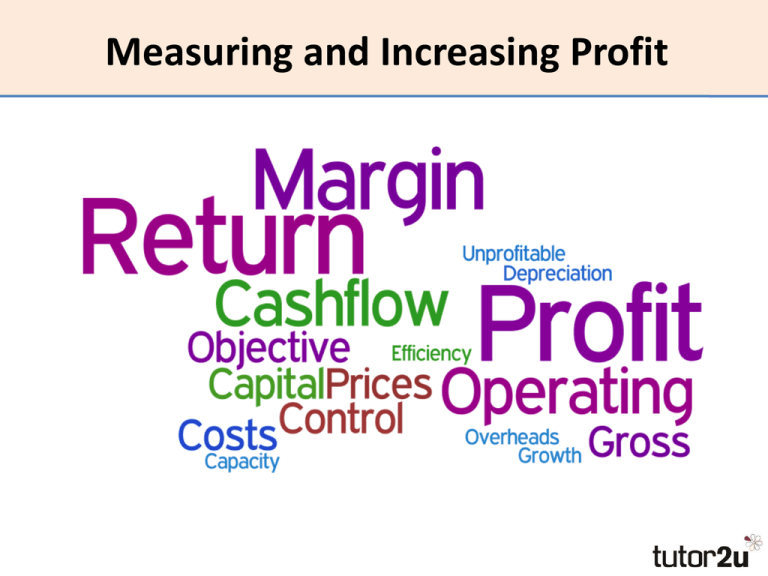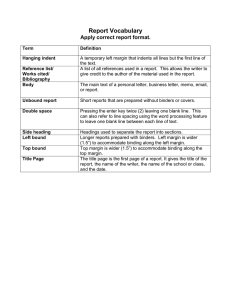What is Net Profit?
advertisement

Measuring and Increasing Profit Unit 1 Reminder – What is Profit? Profit is the reward or return for taking risks & making investments Profit as an Objective • For most businesses, making a profit is a key objective • Profit is the most important source of cash flow & finance for a business • Remember that there can be reasons for running a business other than the “profit motive” Calculating Profit Total Sales less Total Costs = Profit (or Loss) Example Sales Costs Profit or Loss? £100,000 £75,000 £25,000 (profit) £100,000 £125,000 £25,000 (loss) Total sales > total costs Total costs > total sales Total sales = total costs = Profit = Loss = Break-even Two Ways of Measuring Profit 1. Profit in absolute terms – The £ value of profits earned – E.g. £50,000 profit made in the year 2. Profit in relative terms – The profit earned as a proportion of sales achieved or investment made – E.g. £50,000 profit from £500,000 of sales is a profit margin of 10% – E.g. £50,000 profit from an investment of £1 million = a 5% return on investment Two Key Terms to Remember Capital The amount invested into a business or project Net profit margin The percentage return made on sales; calculated as net profit divided by sales Net Profit Margin Net Profit Margin – What is Net Profit? Net profit is what is left after all the costs of a business have been taken from its sales revenue Example £’000 Sales 150 Wages (50) Energy costs (25) Marketing (15) Other overheads (30) NET PROFIT Net profit margin 30 20% Net Profit Margin – the formula Net profit margin Net profit (before tax) = X 100 Sales Note: net profit margin is expressed as a percentage What does Net Profit Margin tell us? • How effectively a business turns its sales into profit • How efficiently a business is run • Whether a business is able to “add value” during the production process (a high margin business must be doing something right!) The Importance of Comparison (1) The net profit margin of a business should be compared with other competitors in the same market, and over time Company A £’000 Company B £’000 Company C £’000 Sales 150 250 500 Net profit 50 25 125 20% 10% 25% Example Net margin The Importance of Comparison (2) Example Company A £’000 Company B £’000 Company C £’000 Sales 150 250 500 Net profit 50 25 125 20% 10% 25% Net margin Company A makes a higher net profit than Company B even though its sales are lower – because it has a higher net profit margin Company C makes the highest net margin of these three & also the highest sales. So it makes the largest net profit too Return On Capital What is Capital? Capital is the amount invested in a business Return on capital is the percentage return on that investment Example £’000 Net profit 200 Capital Return on Capital 2,500 8% Return on capital– the formula Return on Capital Net profit (before tax) = X 100 Capital invested Note: return on capital is expressed as a percentage What does Return on Capital tell us? • A measure of the returns made from investing in the business • How good is the business at converting money invested into profit? • Provides a means of comparison with other investment opportunities • Opportunity cost (remember from Unit 1!) – what an investor could have done by investing elsewhere Methods of Improving Profits The Basics of Increasing Profits Increase quantity sold Sales less Variable Costs Increase selling price Reduce VC per unit Increase output less Fixed Costs Reduce fixed costs = Net Profit Increase quantity sold Why? Higher sales volumes = higher sales, assuming that the selling price is not lowered Makes better use of production capacity (i.e. fixed costs should not rise) May result in higher market share Will it work? Depends on elasticity of demand Sales value may actually fall if price has to be reduced to achieve higher sales volumes Does business have capacity to sell more? Why it Competitors are likely to respond might not Marketing efforts may fail – e.g. promotional campaign work does not generate results Fixed costs might actually rise – e.g. higher marketing Increase selling price Why? Higher selling price = higher sales (assuming quantity sold does not fall in response) Maximises value extracted from customers Customers may perceive product as higher quality No need for extra production capacity Will it work? Depends on price elasticity of demand Sales value may actually fall price rise is matched by an even bigger fall in quantity sold It will work if customers remain loyal and still perceive product to be good value Why it Competitors are likely to respond (e.g. prices lower) might not Customers may decide to switch to competitors work Reduce variable costs per unit Why? Increase the value added per unit sold Higher profit margin on each item produced and sold Customers do not notice a change in price Will it work? Yes, if suppliers can be persuaded to offer better prices Yes, if quality can be improved through lower wastage Yes, if operations can be organised more efficiently Why it Lower input costs might mean lower quality inputs – might not which can lead to greater wastage work Customers may notice a decrease in product quality Increase output Why? Provides greater quantity of product to be sold Enables business to maximise share of market demand Spreads fixed costs over a greater number of units Will it work? Yes, if the extra output can be sold (e.g. finding a new market, offering a lower price for a more basic product) Yes, if the business has spare capacity Why it A dangerous option – what if the demand is not there? might not Fixed costs might actually rise (e.g. stepped fixed costs) work Production quality might be compromised (lowered) in the rush to produce more Reduce fixed costs Why? A drop in fixed costs translates directly into higher profits Reduces the break-even output Often substantial savings to be made by cutting unnecessary overheads Will it work? Yes, provided costs cut don’t affect quality, customer service or output A business can nearly always find savings in overheads Why it Might reduce ability of business to increase sales might not Intangible costs – e.g. lower morale after making work redundancies Some more complex approaches • Reduce product range – Business often has too many products = complex operations & inefficiency – Some products may be very low-margin or even loss-making • Outsource non-essential functions – A way of reducing fixed costs – Focus the business on what it is good at – Areas to outsource: e.g. IT, call handling, finance Difference between profit and cash flow Two Different Concepts What is Profit? What is Cash Flow? Sales Cash Inflows less Variable Costs less Cash outflows less Fixed Costs = Net Cash Flow = Net Profit Where cash flow differs from profit • Timing differences – Sales to customers made on credit – Payments to suppliers • The way that fixed assets are accounted for – Payment for fixed asset = cash outflow – Cost of fixed asset = treated as an asset not a cost – Depreciation is charged as cost when the value of fixed assets is reduced Some examples Transaction Example What happens to Profit? What happens to Cash Flow? Customer buys goods for £50,000 on 60 days credit Sales of £50,000 are recognised immediately Cash inflow of £50,000 when the customer actually pays Marketing campaign costing £10,000 ordered from marketing agency Cost of £10,000 included in marketing costs Cash outflow of £10,000 when the marketing agency is paid New factory machinery bought for £150,000 No effect. £150,000 added to the value of fixed assets Cash outflow of £150,000 paid to supplier of machinery Depreciation charge of £100,000 to reflect use of factory fixed assets Depreciation of £100,000 included as a cost No effect on cash flow Test Your Understanding http://www.tutor2u.net/business/quiz/improvingprofit/quiz.html Measuring and Increasing Profit








